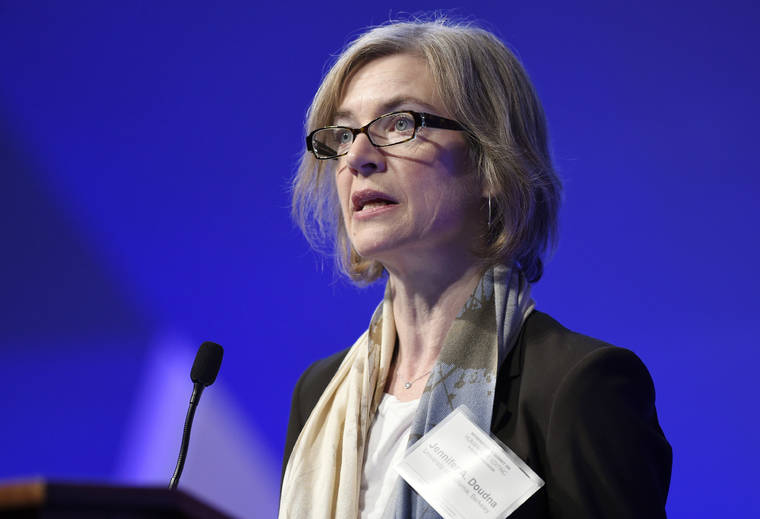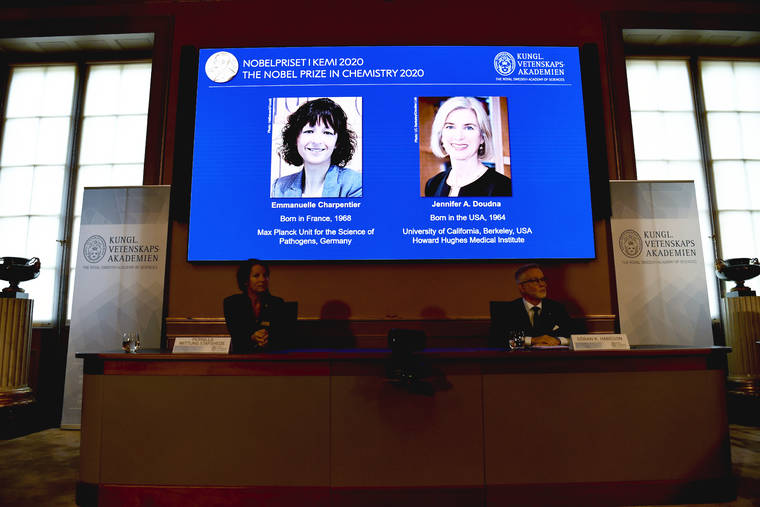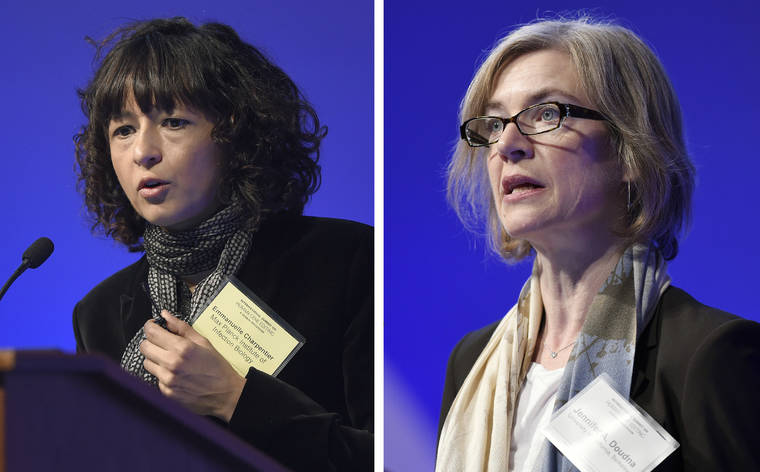Scientist who grew up on Big Island shares Nobel Prize for chemistry

ASSOCIATED PRESS / 2015
Jennifer Doudna, a University of California, Berkeley, co-inventor of the CRISPR gene-editing tool, speaks at the National Academy of Sciences international summit on the safety and ethics of human gene editing, in Washington. The 2020 Nobel Prize for chemistry was awarded today to Emmanuelle Charpentier and Doudna “for the development of a method for genome editing.”

ASSOCIATED PRESS
Professor Pernilla Wittung Stafshede, left, and Goran K. Hansson, Secretary General of the Academy of Sciences, after announcing the winners of the 2020 Nobel Prize in chemistry during a news conference at the Royal Swedish Academy of Sciences, in Stockholm, Sweden, today. The 2020 Nobel Prize for chemistry was awarded to Emmanuelle Charpentier, left on screen, and Jennifer Doudna “for the development of a method for genome editing.”

ASSOCIATED PRESS
This file combo image shows Emmanuelle Charpentier, left, and Jennifer Doudna, both speaking at the National Academy of Sciences international summit on the safety and ethics of human gene editing, in Washington.



STOCKHOLM >> An American scientist who grew up on the Big Island shared the Nobel Prize in chemistry today with a French scientist for developing “molecular scissors” to edit genes, offering the promise of one day curing inherited diseases.
Working on opposite sides of the Atlantic, American Jennifer A. Doudna and Frenchwoman Emmanuelle Charpentier came up with a method known as CRISPR-cas9 that can be used to change the DNA of animals, plants and microorganisms. It was only the fourth time that a Nobel in the sciences was awarded exclusively to women, who have long received less recognition for their work than men in the prize’s 119-year history.
Doudna, 56, is a Hilo High graduate whose family moved to Hawaii island when she was 7. According to a 2015 New York Times profile Opens in a new tab, Doudna’s father taught literature at the University of Hawaii-Hilo and her mother lectured on history at a community college. The Times reported that Doudna found her calling in high school after hearing a lecture by a scientist about her research into how normal cells became cancerous.
Doudna also credits a UH-Hilo biology professor emeritus, Don Hemmes, for igniting her curiosity about the living world and giving her the opportunity to work in his lab one summer, UH-Hilo says on its website.
After graduating from Hilo High, she went on to study at Pomona College in California and Harvard University.
Today was the second day in a row that a woman with ties to Hawaii island won a Nobel Prize. On Tuesday, astronomer Andrea Ghez, of the University of California, Los Angeles, shared in the Nobel Prize for physics Opens in a new tab for work studying a supermassive black hole in the Milky Way galaxy. Ghez has been using the the W.M. Keck Observatory atop Mauna Kea since 1995 for her research.
Don't miss out on what's happening!
Stay in touch with breaking news, as it happens, conveniently in your email inbox. It's FREE!
Charpentier and Doudna’s work allows for laser-sharp snips in the long strings of DNA that make up the “code of life,” enabling scientists to precisely edit specific genes to remove errors that lead to disease in humans — and is already being used for that purpose.
“There is enormous power in this genetic tool, which affects us all,” said Claes Gustafsson, chair of the Nobel Committee for Chemistry. “It has not only revolutionized basic science, but also resulted in innovative crops and will lead to groundbreaking new medical treatments.”
Gustafsson said that, as a result, any genome can now be edited “to fix genetic damage.”
Dr. Francis Collins, who led the drive to map the human genome, said the technology “has changed everything” about how to approach diseases with a genetic cause, such as sickle cell disease.
“You can draw a direct line from the success of the human genome project to the power of CRISPR-cas to make changes in the instruction book,” said Collins, director of the National Institutes of Health, which helped fund Doudna’s work.
But many also cautioned that the technology raises serious ethical questions and must be used carefully.
Much of the world became more aware of CRISPR in 2018, when Chinese scientist He Jiankui revealed he had helped make the world’s first gene-edited babies, to try to engineer resistance to future infection with the AIDS virus. His work was denounced as unsafe human experimentation because of the risk of causing unintended changes that could pass to future generations, and he’s been sentenced to prison in China.
In September, an international panel of experts issued a report saying it’s still too soon to try to make genetically edited babies because the science isn’t advanced enough to ensure safety, but they mapped a pathway for countries that want to consider it.
“Being able to selectively edit genes means that you are playing God in a way,” said American Chemistry Society President Luis Echegoyen, a chemistry professor at the University of Texas El Paso.
Doudna told The Associated Press of her own surprise — including that she learned she’d won from a reporter.
“I literally just found out, I’m in shock,” she said. “I was sound asleep.”
“My greatest hope is that it’s used for good, to uncover new mysteries in biology and to benefit humankind,” said Doudna, who is affiliated with the University of California, Berkeley and is paid by the Howard Hughes Medical Institute, which also supports AP’s Health and Science Department.
Charpentier, 51, spoke of the shock of winning.
“Strangely enough I was told a number of times (that I’d win), but when it happens you’re very surprised and you feel that it’s not real,” she told reporters by phone from Berlin after the award was announced in Stockholm by the Royal Swedish Academy of Sciences. “But obviously it’s real, so I have to get used to it now.”
When asked about the significance of two women winning, Charpentier said that while she considers herself first and foremost a scientist, “it’s reflective of the fact that science becomes more modern and involves more female leaders.”
“I do hope that it will remain and even develop more in this direction,” she said, adding that it’s “more cumbersome to be a woman in science than to be a man in science.”
Three times a woman has won a Nobel in the sciences by herself; this is the first time an all-female team won a science prize. In 1911, Marie Curie was the sole recipient of the chemistry award, as was Dorothy Crowfoot Hodgkin in 1963. In 1983, Barbara McClintock won the Nobel for medicine.
The breakthrough research done by Charpentier and Doudna was published in 2012, making the discovery very recent compared to much Nobel-wining research, which is often only honored after decades have passed.
Speaking to reporters from the Max Planck Unit for the Science of Pathogens in Berlin, which she leads, Charpentier said despite how recently it was developed, the method is now widely used by scientists researching diseases, developing drugs and engineering new plants.
Among the most promising therapies already being developed are for eye diseases and blood disorders, such as sickle cell disease and beta thalassemia, she said. It could also have applications in the growing field of cancer immunotherapy.
Developing hardy crops is another promising direction, said Charpentier. “I think this is very important considering the challenge we are facing of climate change,” she said.
The Broad Institute at Harvard and MIT have been in a long court fight over patents on CRISPR technology, and many other scientists did important work on it, but Doudna and Charpentier have been most consistently honored with prizes for turning it into an easily usable tool.
The prestigious award comes with a gold medal and prize money of 10 million kronor (more than $1.1 million), courtesy of a bequest left more than a century ago by the prize’s creator, Swedish inventor Alfred Nobel. The amount was increased recently to adjust for inflation.
On Monday, the Nobel Committee awarded the prize for physiology and medicine for discovering the liver-ravaging hepatitis C virus. Tuesday’s prize for physics honored breakthroughs in understanding the mysteries of cosmic black holes.
The other prizes are for outstanding work in the fields of literature, peace and economics.



